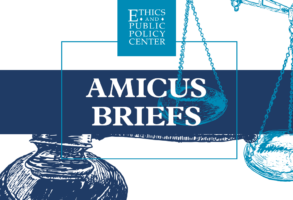
Published May 4, 2023
On April 13, 2023, the Department of Education (ED) issued a notice of proposed rulemaking (NPRM) titled “Nondiscrimination on the Basis of Sex in Education Programs or Activities Receiving Federal Financial Assistance: Sex-Related Eligibility Criteria for Male and Female Athletic Teams.” This Athletics NPRM would establish a new regulatory standard under Title IX that would govern sex-related criteria as it relates to gender identity for participation on sex-specific athletics teams at federally funded educational institutions. The 32-day public comment period closes on Monday, May 15.
In July 2022, when ED issued a proposed Title IX rule that would expand Title IX’s sex discrimination prohibition to prohibit discrimination based on gender identity (among other things), the Department promised it would issue a separate NPRM to address “whether and how” ED should amend its current athletics regulation and “the question of what criteria, if any, recipients should be permitted to use to establish students’ eligibility to participate on a particular male or female athletics team.”
Proposed Regulatory Standard
Under the current athletics regulation, originally promulgated in 1980, educational institutions may “operate or sponsor separate teams for members of each sex where selection for such teams is based upon competitive skill or the activity involved is a contact sport.”
According to ED, the current athletics regulation isn’t “sufficiently clear” to ensure Title IX’s nondiscrimination requirement is satisfied. The proposed regulatory standard “would provide needed clarity” and “would not affect a recipient’s discretion” to offer sex-specific teams based on competitive skill or for contact sports.
Citing to Bostock v. Clayton County, Executive Order 13988 on “Preventing and Combating Discrimination on the Basis of Gender Identity or Sexual Orientation,” Executive Order 14021 on “Guaranteeing an Educational Environment Free from Discrimination on the Basis of Sex, Including Sexual Orientation or Gender Identity,” the Department proposes the following regulatory text:
If a recipient adopts or applies sex- related criteria that would limit or deny a student’s eligibility to participate on a male or female team consistent with their gender identity, such criteria must, for each sport, level of competition, and grade or education level: (i) Be substantially related to the achievement of an important educational objective; and (ii) Minimize harms to students whose opportunity to participate on a male or female team consistent with their gender identity would be limited or denied.
In crafting its proposal, ED conducted “an extensive review” of Title IX’s implementing regulations, statutory text, and legislative history; federal and state case law (including Hecox v. Little, A.M. v. Indianapolis Public Schools, and B.P.J. v. West Virginia State Board of Education); relevant state laws; current athletic policies; public comments received during a June 2021 nationwide virtual public hearing on Title IX; and “other information provided by stakeholders.”
According to the NPRM, the proposed standard was informed by the current Title IX regulation governing single-sex classes and Equal Protection Clause caselaw, and is “consistent” with Title IX’s nondiscrimination prohibition and the framework of the current athletics regulations.
Criteria for Each Sport, Level of Competition, and Grade or Education Level
Under the proposed regulatory standard, any sex-specific policy that does not permit participation based on gender identity would have to be evaluated based on (a) sport, (b) level of competition, and (c) the grade or education level. Indeed, the NPRM states that criteria that “categorically exclude all transgender girls and women from participating on any female athletic teams” would not satisfy the proposed standard because they would take a “one-size-fits-all approach” and rely on “overbroad generalizations” that are not specific to the sport, level of competition, and grade or education level to which they apply.
Without elaboration, the Department declares that it “currently believes” there are “few, if any, sex-related eligibility criteria applicable to students in elementary school” that would comply with the proposed standard. ED further believes it would also be “particularly difficult” for a policy that excludes students “immediately following elementary school” from participating on sex-specific teams consistent with their gender identity to comply with the standard. If adopted, this view would likely undermine any sex-specific distinctions for athletics in elementary schools.
Even in high schools and colleges, the level of evaluation required under the NPRM places an onerous burden on recipients seeking to adopt any sex-specific policy based on biology and provides a large incentive to adopt a blanket policy allowing participation based on gender identity for all sex-specific athletic teams.
Nevertheless, ED “anticipates that some uses of sex-related eligibility criteria” would satisfy the proposed standard “in some sports, grade and education levels, and levels of competition” (emphasis added).
Substantially Related to the Achievement of an Important Educational Objective
Under the proposed regulatory standard, any sex-specific policy must be based on a ‘‘direct, substantial relationship” between a recipient’s objective and the means used to achieve that objective.
ED acknowledges that ensuring fairness in competition and prevention of sports-related injury are “possible important educational objectives,” but is quick to point that that those interests do “not necessarily require schools to adopt or apply sex-related criteria that would limit or deny a student’s eligibility to participate on a male or female team consistent with their gender identity.” The NPRM points to alternative strategies and mitigating measures that could be taken instead, such as “appropriate coaching and training, requiring use of protective equipment, and specifying rules of play.”
According to the Department, the following would not qualify as an important educational objective:
-Communicating or codifying disapproval of a student or a student’s gender identity;
-Adoption solely for the purpose of excluding transgender students from sports;
-Requiring adherence to sex stereotypes;
-Adoption solely for the purpose of administrative convenience; or
-As a pretext for an impermissible interest in singling out transgender students for disapproval or harm.
The NPRM emphasizes that any criteria must not rely on “overly broad generalizations” about male and female students’ “talents, capacities, or preferences,” noting that “very few female student-athletes are transgender” and “transgender students do not necessarily have greater physical or athletic ability than cisgender students that would affect cisgender students’ equal opportunity to participate.” As such, criteria that “assume all transgender girls and women possess an unfair physical advantage over cisgender girls and women in every sport, level of competition, and grade or education level” would rely on an impermissible generalization.
Benefits, Harms, and Costs
ED identifies two benefits of its proposal: (i) “providing a standard to clarify Title IX obligations for recipients that adopt or apply sex-related eligibility criteria,” and (ii) “protecting students’ equal opportunity to participate on male and female teams consistent with Title IX.”
Without the proposed regulation, ED claims “some students may suffer harm as a result of being unable to gain the benefits associated with equal opportunity to participate on athletic teams at school” because participation on a team inconsistent with a student’s gender identity is “not a viable option for many students.” No mention is made of any harm to other students, especially female athletes who could be denied equal opportunity to participate under the Department’s proposal.
ED estimates that the cost to recipients over 10 years would be in the range of $23.4 million to $24.4 million, which seems low considering the number of schools that receive federal funding, the time needed to evaluate existing athletic policies for compliance, and the regular trainings on the policies.
Nevertheless, ED concludes that the benefits “far outweigh the costs.”
Federalism Concerns
As recognized in the NPRM, at least twenty states have passed laws that prevent biological males, regardless of how they identify, from joining female-specific athletic teams.
The Department acknowledges (without elaboration) that its proposal “may have federalism implications” or “substantial direct effects” on the states or the relationship between stated and the federal government. It is clear that the proposed regulation conflicts with state laws, setting up a legal battle between ED and those states if and when the proposed rule is finalized.
Rachel N. Morrison is a Fellow at the Ethics and Public Policy Center, where she directs EPPC’s HHS Accountability Project. An attorney, her legal and policy work focuses on religious liberty, health care rights of conscience, the right to life, nondiscrimination, and civil rights.
Rachel N. Morrison is a Fellow at the Ethics and Public Policy Center, where she directs EPPC’s HHS Accountability Project. An attorney, her legal and policy work focuses on religious liberty, health care rights of conscience, the right to life, nondiscrimination, and civil rights.











